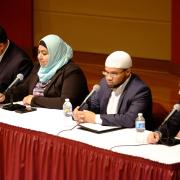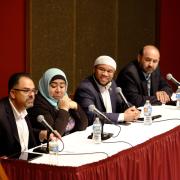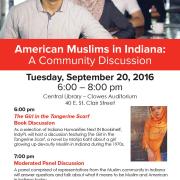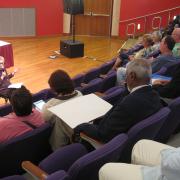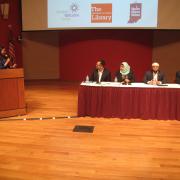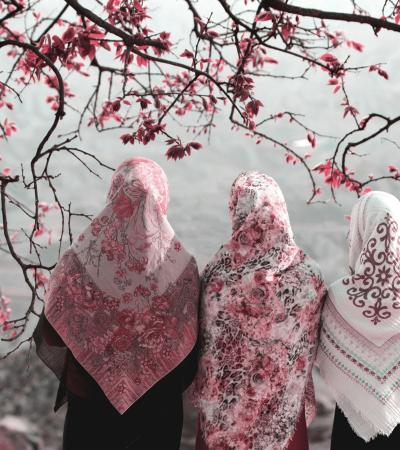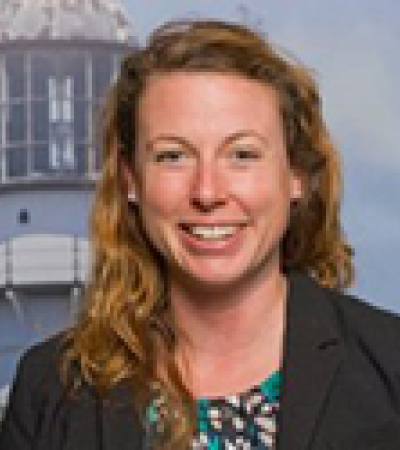Young Adult
Adults
Intergenerational
American Muslims in Indiana: A Community Discussion
$1,001-2,500
The Indianapolis Public Library held a book discussion and community conversation examining what it means to be American and Muslim, from the 1970s to today.
Advanced Planning
Our planning process began in January 2016 in preparation for Indiana’s Bicentennial Celebration and Welcoming Week. We developed partnerships with the Muslim Alliance of Indiana and the Immigrant Welcome Center, two local community organizations with a vested interest in creating conversation.
Our goal was creating an opportunity for the community to engage in conversation about what it means to be American and Muslim in Indiana. As a first step, we chose the book "The Girl in the Tangerine Scarf" from a pre-selected list from Indiana Humanities' Next Indiana Bookshelf, which offered perspective into life in Indiana in the 1970s.
The book discussion was scheduled for Sept. 20, 2016, at 6 p.m., and it was followed by a moderated panel discussion at 7 p.m. the same day.
Marketing
General promotion for the event began in the spring, and more targeted efforts started three to four weeks before the programs took place.
We used printed posters and fliers that we shared around Indianapolis, sent email blasts out to contacts, and shared information on social media, including Twitter and Facebook.
Our partners shared the same information on their websites. Our book discussion facilitator conducted a telephone interview with the author of the book, which was published in a local newspaper. We were also invited to speak with local TV media about the program series and conversation in advance.
Budgeting
The budget for this event was about $1,500. We spent money on printed materials and for the book discussion facilitator. In retrospect, we should have spent additional funds to bring the author of the book to Indianapolis so she could personally facilitate the book discussion.
Day-of-event Activity
We hosted the event in the auditorium at Central Library. The on-staff auditorium technician handled the stage set-up and technology needs. Greeters and staff members assisted with coordination of the book discussion. We also distributed notecards and pens for the Q&A portion and evaluation forms.
The morning of the program, there were security concerns due to the terrorist attacks that had occurred a few days earlier in New York and New Jersey. We weren’t sure how this would impact attendance, but found it necessary to assure everyone involved that we had security measures in place and planned to proceed with the program. We also had several members of the media show up for interviews without prior notification.
We started with the book discussion and showed a short film that featured Muslims who live and work for a large company in Indianapolis. The panel discussion was moderated by Aishah Hasnie, a local TV anchor who is Muslim. The panelists were selected by a partner organization and included varying perspectives and experiences of American Muslims in Indiana. The panel included:
- Faryal Khatri, communications director, Islamic Society of North America (ISNA)
- Edward Curtis, professor of religious studies, Indiana University – Purdue University Indianapolis
- Dr. Ahmed Saltagi, a local physician
- Julius Mansa, a military veterant and interim executive director, Islamic Da'wah Center
Program Execution
We had about 70 attendees at the book discussion and 80 at the panel discussion, with some attendee overlap.
During the discussion, we used notecards so attendees could submit written questions without fear or embarassment. Many questions were asked, including:
- Is Islam a violent religion? Why do so many Muslims participate in acts of violence?
- Why do Muslim nations (e.g. Saudi Arabia) not accept refugees? Why should the U.S. accept refugees if they refuse?
- How have your lives changed as Muslim Americans since 9/11?
We also covered topics such as the Quran and violence, the connection between Christianity and Islam, connecting with Muslim students on college campuses, opportunities for interfaith/intra-faith interactions and economic/business opportunities.
We used a simple evaluation form asking general demographic info, such as zip code and age. We also asked questions to determine whether the person in attendance learned any new information by attending the program. (See the evaluation form under Attachments at right.)
Advice
Be sure to partner with organizations with a vested interest in seeing the conversation be successful.
Supporting Materials
- Feedback (Coming Soon!)
- Programming Librarian Facebook Group

